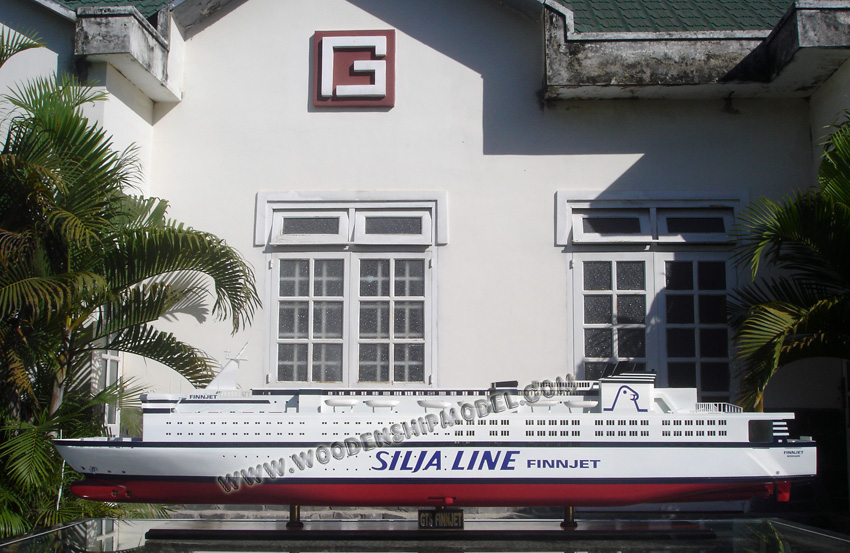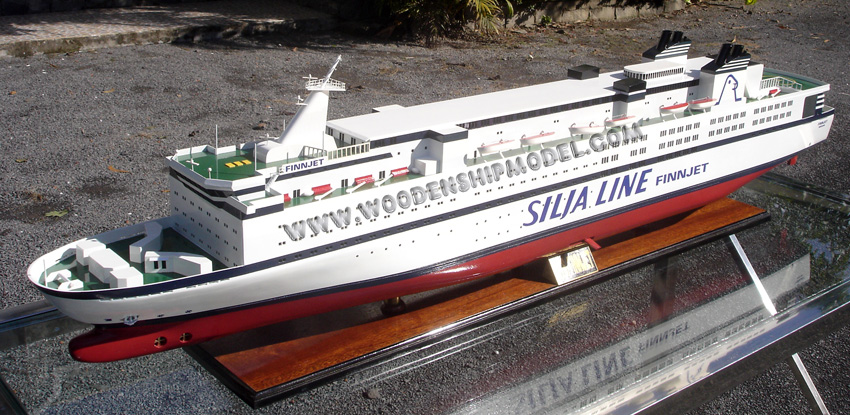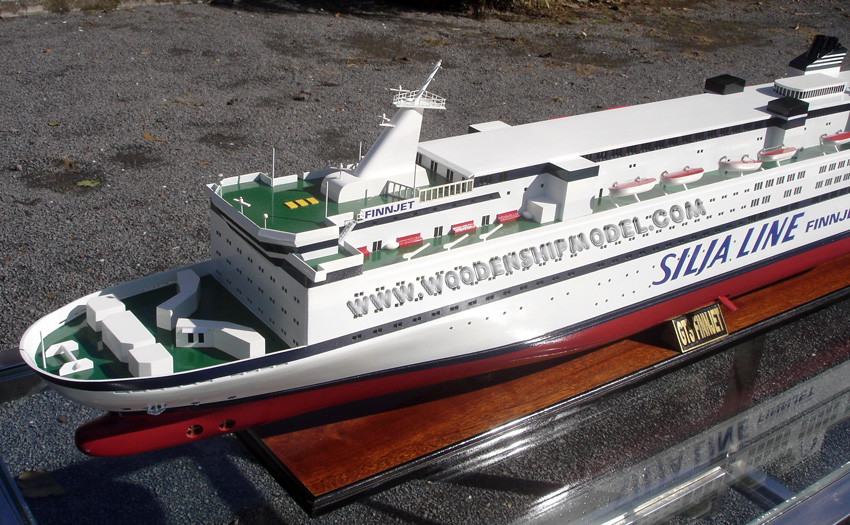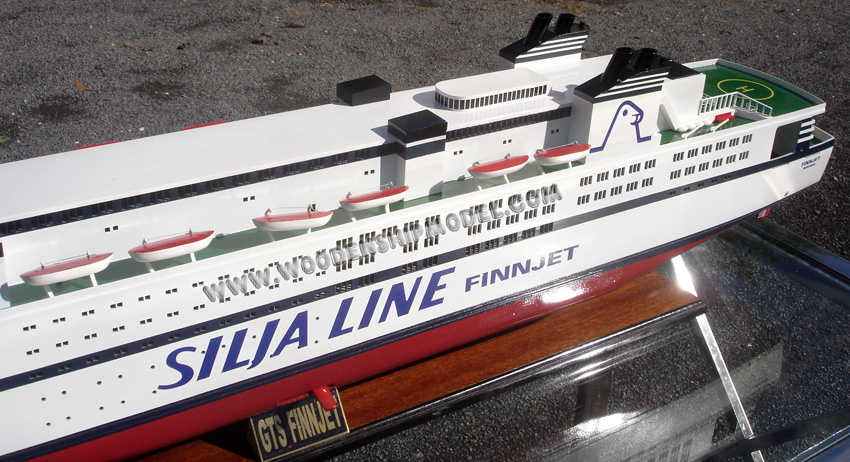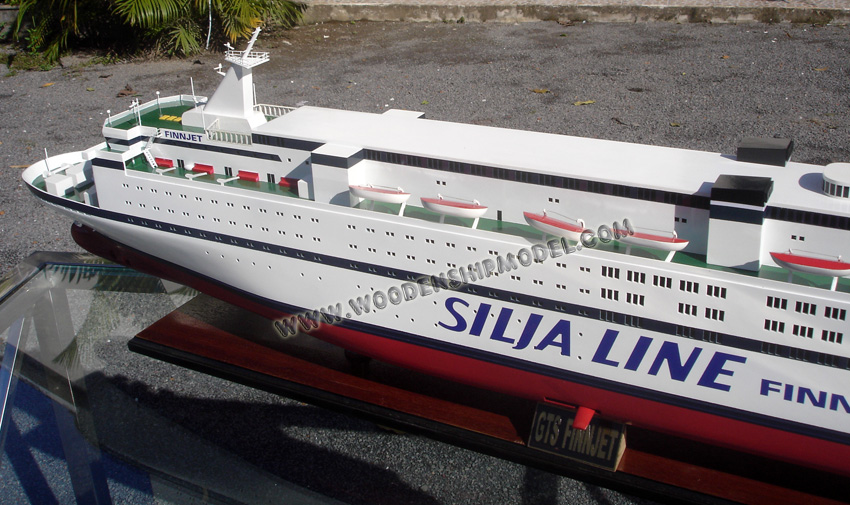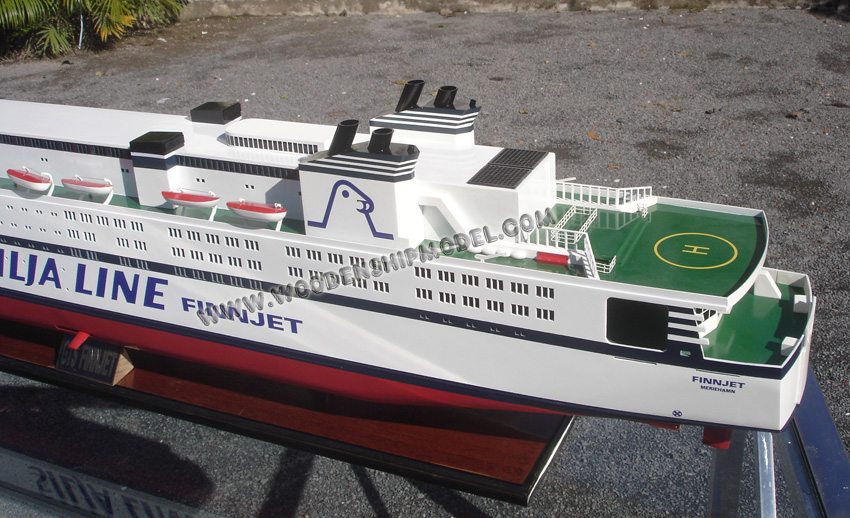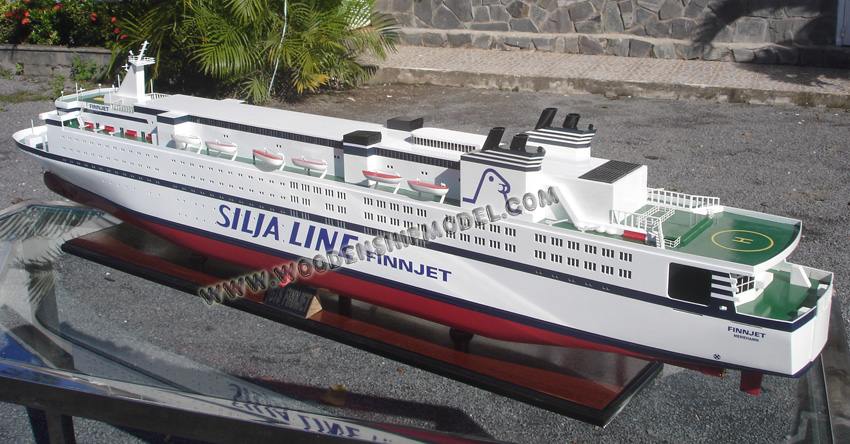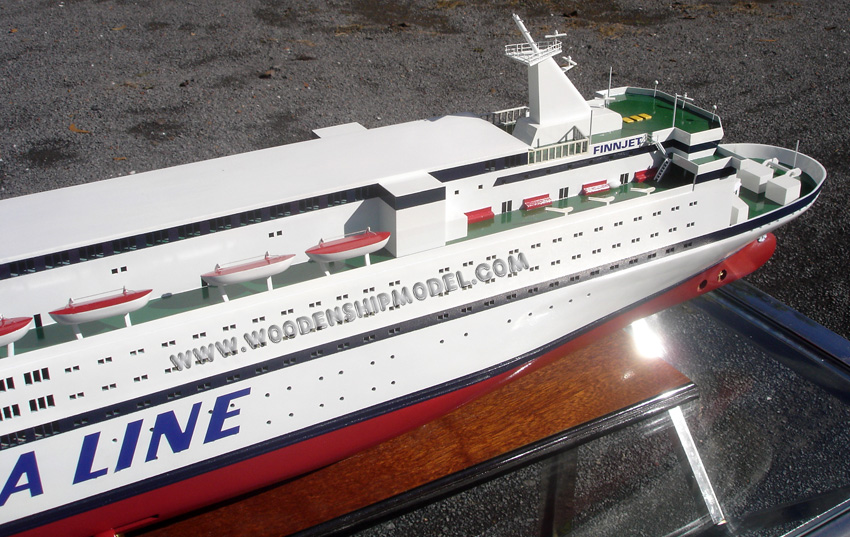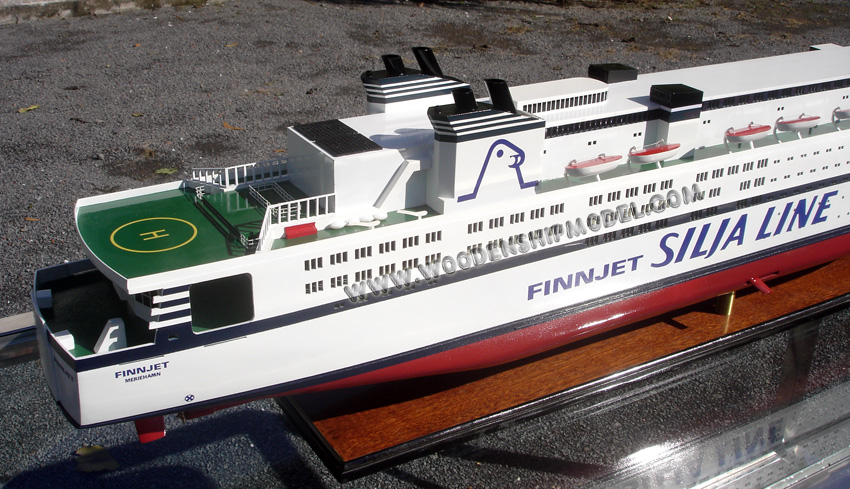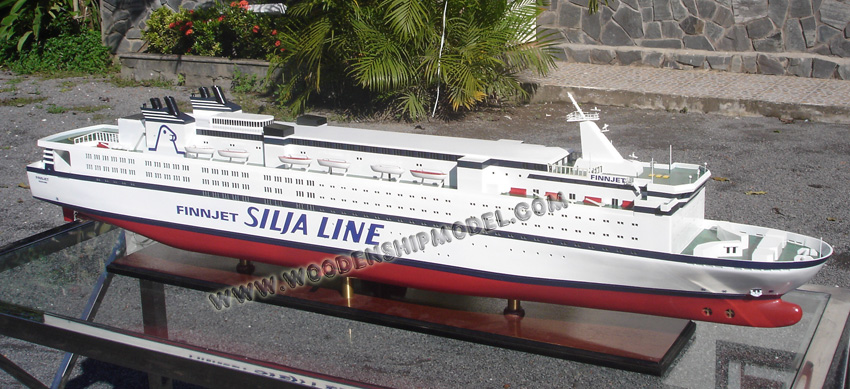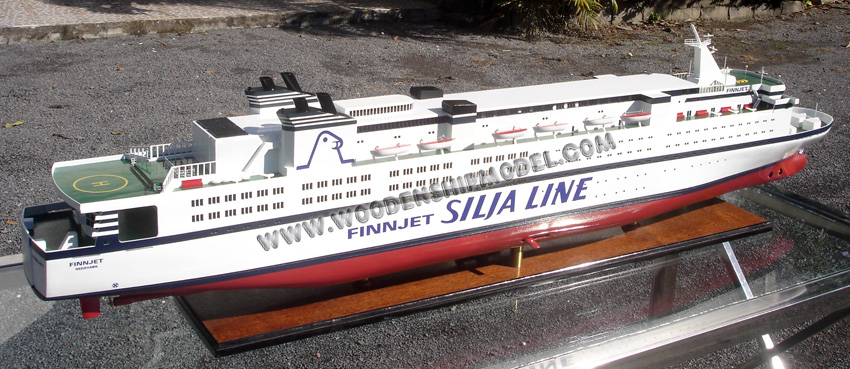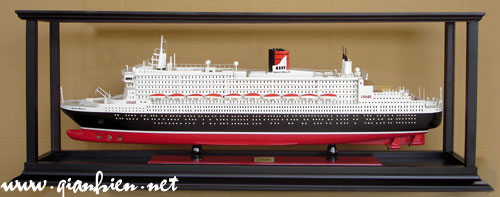|
HISTORY
GTS Finnjet was a
cruiseferry, built in 1977 by Wärtsilä Helsinki, Finland for
Finnlines traffic between Finland and Germany. At the time
of her delivery, Finnjet was the fastest, longest and
largest car ferry in the world, and the only one powered by
gas turbines. At the point of her scrapping in 2008, she
remained the fastest conventional ferry in the world, with a
recorded top speed of 33.5 knots (62.0 km/h; 38.6 mph).
Finnjet had remained out of service since 2005, laid up in
Baton Rouge, Freeport and Genoa. Although she was purchased
by Club Cruise in November 2007 and renamed MS Da Vinci in
January 2008 for rebuilding into a cruise ship, the ship was
sold for scrap in May 2008. Following the sale she was
renamed MS Kingdom for her final voyage to the scrapyard in
Alang, India where scrapping finally started in September
2008. Service
history
This section includes a list of references, but its sources
remain unclear because it has insufficient inline citations.
Please
help to improve this article by introducing more precise
citations. (December 2008)
1977–1987
The Finnjet's maiden voyage was originally scheduled to
depart from Helsinki on 1 May 1977. However, this was
delayed due to an engine officers' strike. Finally the ship
left on her maiden voyage on 13 May 1977, after a final
turbine
test drive had been carried out on 12 May 1977.
Finnjet's estimated fuel consumption for the 22-hour travel
time was 300 tonnes of fuel; approx 350,000 litres total or
16,000 litres per hour. Initially Finnjet was not a very
profitable ship and after only a few years of service there
were
rumours that she would be sold. The ship had been ordered in
the same year as the beginning of the 1973 oil crisis, which
reached its peak around the time of the ship's launch. Yet
another huge leap of the oil price occurred near the turn of
the
decade. To increase her profitability, the ship was
converted to a combined diesel-electric and gas propulsion
with the
addition of diesel-electric generators in 1981 in
Amsterdamse Droogdok Maatschappij, Amsterdam. The change
allowed to
operate the ship at slower speeds, using cheaper fuel during
the winter months. On the way to the shipyard she became
the largest ship to have passed through the Kiel Canal at
that time. A year later 75% of Finnjet??'?s shares were sold
to
Effoa (one of the owners of Silja Line), and Finnjet Line
was established as a joint venture of Finnlines and Effoa to
operate the Finnjet. Starting from November 1985, Finnjet
made 24-hour (later 22-hour) backtracking cruises from
Helsinki
during the winter season. The final batch of these cruises
in October–December 1995 included a short stop in Tallinn.
In
January 1986 another major renovation was carried out at
Wärtsilä Helsinki, with new Commodore-class cabins added in
place of the old sundeck. Shortly after the refit the
Denmark-based DFDS made an offer to buy the Finnjet, but the
offer
was refused. Instead, in June of the same year Finnlines
sold their remaining shares of the Finnjet to Effoa. In the
beginning of 1987 the ship was painted in Silja Line's
colors and incorporated in Silja's fleet. However, the
technical
responsibility for operating the Finnjet remained with
Finnlines until May 1989 (this was of little consequence as
Finnlines
was almost entirely owned by Effoa at the time).
1987–2005
After the ship had become a part of the Silja Line fleet,
further renovations at Howaldtswerke-Deutsche Werft Kiel (HDW)
in 1987, 1988 and 1989 saw almost all of the ship's public
spaces rebuilt. In 1990 Effoa merged with its fellow Silja
Line
partner Johnson Line to form EffJohn. In 1991 an extremely
large-scale reconstruction was planned, where the ship would
have been lengthened by 20 metres (66 ft), cabins enlarged,
a new outdoor swimming pool added, and much of the
superstructure built to a sleeker appearance. Unfortunately
the plan proved to be too costly and was abandoned; the
funds
that had been raised for this reconstruction went to the
rebuilding of MS Svea and MS Wellamo into Silja Karneval and
Silja Festival.
Starting from 1992 Finnjet was used to monitor surface-layer
chlorophyll, temperature and salinity in waters she sailed
through for research by the Finnish Institute of Marine
Research. A new transmission system installed in 1994 (again
at
HDW Kiel) raised the top speed to 33 knots (61 km/h) and
allowed for a mixed operation of turbines and diesel
engines.September of the same year MS Estonia, Finnjet's
former fleetmate, sank during a heavy storm on the North
Baltic. Finnjet was amongst the ferries used to search for
survivors on the disaster area but she had to leave soon
when
cars carried on her upper cardeck started moving in the
heavy seas, creating another potentially dangerous
situation. In
1997 Finnjet was docked at Götaverken Cityvarvet, Gothenburg
and rebuilt with a larger tax-free shop in preparation for
her new itenaries where she served on the Helsinki–Travemünde
route only during the summer months, the rest of the
year sailing on the Helsinki–Tallinn route. Originally the
port in Tallinn was Muuga, but when the ship-way of
Tallinn's old
harbour was reconstructed in 1998, Finnjet moved there from
the start of January 1999. Between 1997 and 2000
segments for the Finnish comedy series Huuliveikot were shot
on board the Finnjet.
In 1999 the summer-route was altered to Helsinki–Tallinn–Rostock.
In autumn of the same year the Finnish Institute of
Marine Research installed new equipment for monitoring water
quality and algae. In 2001 the ship was docked with
modifications made to the turbines and propeller shaft.
These and a new bottom paint allowed her to increase her top
speed once more, to 33.5 knots (62.0 km/h; 38.6 mph). In
mid-May 2002, only a few days after Finnjet's 25th
anniversary
cruise, Finnish newspaper Helsingin Sanomat reported the
ship was for sale. At the time the information was thought
to be
false but later reports indicate the Finland-based Eckerö
Line did consider buying her around that time. In April 2004
Finnjet called in Helsinki for the last time, after which
she left for another refit at Aker Finnyards, Rauma in
preparation for
her new Saint Petersburg – Tallinn – Rostock route. During
the refit most of her interiors were entirely rebuilt, new
rudders
were installed and bridge wings covered. The new route was
believed to be profitable all year round, but this proved
not to
be the case. After the first summer season Finnjet was laid
up for the winter 2004/2005. The route was eventually
terminated after the 2005 summer season, and the ship was
put up for sale.
|

